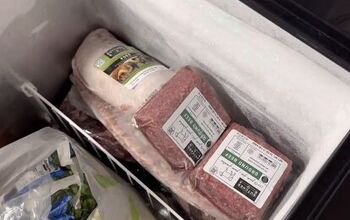Best Great Depression Era Cookbooks: Culinary Wisdom From Tough Times
The Great Depression, spanning the 1930s, was a time of economic hardship that forced many families to stretch their resources and get creative with meals.
Cookbooks from the depression era, or inspired by it, offer a window into the frugal, resourceful, and resilient cooking practices that defined that time.
Whether you’re a history buff, a culinary enthusiast, or someone looking to embrace more economical cooking methods, these cookbooks provide invaluable insights.
Below are some of the best Great Depression era cookbooks and resources that capture the essence of cooking during one of America's most challenging periods.
Disclaimer: Simplify may receive a small affiliate commission from purchases made via links in this article but at no cost to you.
1. Clara's Kitchen: Wisdom, Memories, and Recipes from the Great Depression
Clara Cannucciari became a YouTube sensation in her later years with her YouTube channel, "Great Depression Cooking" where she shared recipes and stories from her childhood during the Depression. Her videos offer a unique blend of history and practical cooking advice, making her a modern-day chronicler of Depression-era cuisine.
Clara’s recipes, such as her famous "Poorman's Meal," highlight the simplicity and ingenuity required to make delicious meals from limited ingredients.
Her work serves as an accessible and heartfelt tribute to the resourcefulness of that era, making it a must-watch for anyone interested in Depression era cooking.
As well as finding Clara's recipes on YouTube, you can also find them in her book Clara's Kitchen: Wisdom, Memories, and Recipes from the Great Depression.
Clara's Kitchen: Wisdom, Memories, and Recipes from the Great Depression
2. "The Joy of Cooking" by Irma S. Rombauer
Originally published in 1931, "The Joy of Cooking" by Irma S. Rombauer quickly became an essential resource in American kitchens. This cookbook emerged as a beacon of hope and practicality during the Great Depression, offering recipes that were not only economical but also uplifting during tough times.
What sets "The Joy of Cooking" apart is its comprehensive approach to meal preparation. Rombauer included a wide range of recipes, from simple soups and stews to more elaborate dishes, all designed to be adaptable based on what was available.
The book’s conversational tone and straightforward instructions made it accessible to both novice and experienced cooks, and it has since evolved through many editions while retaining its original charm.
Even today, "The Joy of Cooking" remains a beloved resource for those looking to cook wholesome, budget-friendly meals.
Its enduring popularity is a testament to its practicality and the comfort it brought to millions during the Depression.
The Joy of Cooking by Irma S. Rombauer
3. "The Settlement Cookbook" by Lizzie Black Kander
First published in 1901, "The Settlement Cookbook" by Lizzie Black Kander might predate the Great Depression, but it became a crucial resource during the 1930s. The book was originally created to help immigrants adapt to American life, teaching them not only how to cook but also how to manage a household efficiently.
During the Great Depression, the recipes in "The Settlement Cookbook" were particularly valuable because they focused on simple, economical meals that could be made with limited ingredients. The book’s emphasis on thrift and practicality resonated with Depression-era cooks, who needed to stretch their food budgets as far as possible.
"The Settlement Cookbook" includes a variety of recipes that are adaptable and straightforward, from breads and soups to casseroles and desserts. Its timeless advice on frugality and resourcefulness in the kitchen continues to make it a relevant resource even today.
The Settlement Cookbook by Lizzie Black Kander
4. "American Woman's Cook Book" by Ruth Berolzheimer
Published in the 1930s, "The American Woman's Cook Book" by Ruth Berolzheimer is another gem from the Great Depression era.
This cookbook was compiled with the aim of helping American women navigate the challenges of feeding their families on a tight budget. It includes a wealth of recipes that emphasize cost-effective ingredients and efficient cooking methods.
One of the standout features of "The American Woman's Cook Book" is its inclusion of tips for meal planning and budgeting, which were crucial for families trying to make ends meet during the Depression.
The book covers everything from basic pantry staples to more elaborate dishes, all while maintaining a focus on economy and nutrition.
Ruth Berolzheimer’s work is a testament to the creativity and resilience of home cooks during the Depression. The recipes and advice in this book offer a fascinating glimpse into the culinary landscape of the 1930s and remain a valuable resource for anyone interested in historical cooking practices.
"American Woman's Cook Book" by Ruth Berolzheimer
Depression era cookbooks
The Great Depression was a time of significant hardship, but it also fostered a culture of resilience, creativity, and thrift that is reflected in the cookbooks of the era.
Whether it’s through Clara Cannucciari’s modern-day reflections, the enduring wisdom of "The Joy of Cooking," the practicality of "The Settlement Cookbook," or the budget-friendly advice in "The American Woman's Cook Book," these resources provide a wealth of knowledge for those looking to explore Depression-era cooking.
These cookbooks are more than just collections of recipes; they are historical documents that offer insight into how people lived, ate, and persevered during one of the most challenging periods in American history.
By revisiting these works, we can learn valuable lessons in frugality and resourcefulness that are just as relevant today as they were in the 1930s.


























Comments
Join the conversation